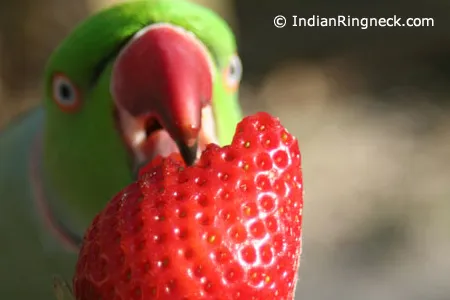Indian Ringneck parrots, also known as Asiatic parrots, thrive on a diverse and balanced Indian Ringneck parrot diet. These vibrant birds are not fussy eaters and will eagerly consume fruits, vegetables, seeds, and pellets when offered. In my years of experience breeding and caring for them, even the pickiest individuals quickly adapt to nutritious options, leading to healthier, more active pets. This guide draws from wild behaviors and captive care best practices to help you provide optimal nutrition.
For bird enthusiasts exploring varied diets, check out food for parrotlets for additional insights into small parrot nutrition.
Diet of Wild Ringnecks
In their natural habitats, wild Indian Ringnecks forage for a wide array of foods, mirroring the variety needed in captivity. They relish fresh fruits, blossoms, berries, and seeds, often raiding orchards which earns them a reputation as pests among farmers in Southeast Asia and even feral populations in places like Bakersfield, California. These birds damage crops by pecking at unripe fruits, but they also sustain themselves on ground-level options like dandelion leaves when trees are scarce.
Occasionally, they supplement with insects for protein, ensuring a balanced intake. This opportunistic eating highlights their adaptability—no edible item is off-limits in the wild. Understanding this foundation helps replicate a natural Indian Ringneck parrot diet at home, promoting longevity and vitality.
 Indian Ringneck parrots foraging on fruits and vegetables in a natural setting
Indian Ringneck parrots foraging on fruits and vegetables in a natural setting
Diet for Captive Ringnecks
Crafting a captive Indian Ringneck parrot diet is straightforward and rewarding, focusing on fresh fruits, vegetables, seeds, and pellets for complete nutrition. Avoid relying solely on seeds or pellets, as this deprives them of essential variety, leading to boredom, nutritional gaps, and potential health issues like obesity or deficiencies.
Many owners debate pellets, especially those with dyes, but my breeding experience shows no adverse effects when balanced properly. My Ringnecks remain vibrant and healthy on a rotated mix. Start simple: offer a spectrum of foods to mimic their wild foraging instincts.
Incorporating Seeds Safely
Seeds form a natural part of any Indian Ringneck parrot diet, as these birds consume them abundantly in the wild. However, seeds alone are high in fat and can cause liver problems or shorten lifespan if overfed. Breeders once vilified seeds due to all-seed diets causing issues, but moderation is key—they’re safe and beneficial in limited amounts.
Aim for seeds as 20-25% of the diet, rotated with other foods to prevent selective eating.
Rotating Seeds and Pellets
Mixing seeds and pellets isn’t ideal, as clever Ringnecks will pick seeds and ignore pellets. Instead, rotate: four days of seeds followed by three days of pellets. This ensures full consumption and avoids nutrient overload from constant pellets.
If your bird resists pellets, introduce them gradually by mixing small amounts with seeds to prevent self-starvation. Patience yields results, as my birds transitioned seamlessly.
For pellet alternatives, explore options like wild harvest cockatiel blends, which suit similar parrot species.
Essential Fruits and Vegetables
Fruits are a highlight of the Indian Ringneck parrot diet, with apples being a top favorite—watch them guzzle juice and shred the flesh in minutes. Grapes, oranges, kiwis, pears, mangos, and melons also delight them, delivering antioxidants and hydration. Always use fresh, ripe produce; discard anything spoiled to avoid bacterial risks.
Vegetables round out the menu: raw baby carrots entertain for hours, while leafy greens like kale or spinach are torn into bites. Cooked squashes—pumpkin, zucchini, or banana—offered warm and cubed, are hits too. Experiment creatively, as variety keeps them engaged and healthy.
 Indian Ringneck parrot munching on fresh fruits like apples and grapes
Indian Ringneck parrot munching on fresh fruits like apples and grapes
Adding Protein Sources
Protein is crucial but sparing in an Indian Ringneck parrot diet—excess can strain kidneys. Offer small portions of cooked, unseasoned meats like shredded turkey or chicken once weekly. Remove uneaten portions after an hour to prevent spoilage.
Incorporate naturally via insects or legumes if preferred, maintaining balance.
Final Tips for Longevity
A well-rounded Indian Ringneck parrot diet—blending seeds, pellets, fruits, veggies, and protein—can extend your bird’s life into its 20s or beyond. Prep meals alongside your own cooking for efficiency, storing portions safely. Consult avian vets for personalized advice, especially for young or breeding birds.
Embrace the joy of feeding these curious parrots; their enthusiasm rewards your efforts. For more parrot care tips, explore our related articles!
